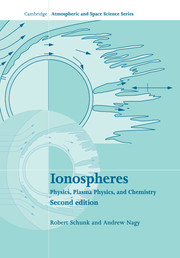Book contents
- Frontmatter
- Contents
- Chapter 1 Introduction
- Chapter 2 Space environment
- Chapter 3 Transport equations
- Chapter 4 Collisions
- Chapter 5 Simplified transport equations
- Chapter 6 Wave phenomena
- Chapter 7 Magnetohydrodynamic formulation
- Chapter 8 Chemical processes
- Chapter 9 Ionization and energy exchange processes
- Chapter 10 Neutral atmospheres
- Chapter 11 The terrestrial ionosphere at middle and low latitudes
- Chapter 12 The terrestrial ionosphere at high latitudes
- Chapter 13 Planetary ionospheres
- Chapter 14 Ionospheric measurement techniques
- Appendix A Physical constants and conversions
- Appendix B Vector relations and operators
- Appendix C Integrals and transformations
- Appendix D Functions and series expansions
- Appendix E Systems of units
- Appendix F Maxwell transfer equations
- Appendix G Collision models
- Appendix H Maxwell velocity distribution
- Appendix I Semilinear expressions for transport coefficients
- Appendix J Solar fluxes and relevant cross sections
- Appendix K Atmospheric models
- Appendix L Scalars, vectors, dyadics, and tensors
- Appendix M Radio wave spectrum
- Appendix N Simple derivation of continuity equation
- Appendix O Numerical solution for F region ionization
- Appendix P Monte Carlo methods
- Index
Chapter 8 - Chemical processes
Published online by Cambridge University Press: 22 January 2010
- Frontmatter
- Contents
- Chapter 1 Introduction
- Chapter 2 Space environment
- Chapter 3 Transport equations
- Chapter 4 Collisions
- Chapter 5 Simplified transport equations
- Chapter 6 Wave phenomena
- Chapter 7 Magnetohydrodynamic formulation
- Chapter 8 Chemical processes
- Chapter 9 Ionization and energy exchange processes
- Chapter 10 Neutral atmospheres
- Chapter 11 The terrestrial ionosphere at middle and low latitudes
- Chapter 12 The terrestrial ionosphere at high latitudes
- Chapter 13 Planetary ionospheres
- Chapter 14 Ionospheric measurement techniques
- Appendix A Physical constants and conversions
- Appendix B Vector relations and operators
- Appendix C Integrals and transformations
- Appendix D Functions and series expansions
- Appendix E Systems of units
- Appendix F Maxwell transfer equations
- Appendix G Collision models
- Appendix H Maxwell velocity distribution
- Appendix I Semilinear expressions for transport coefficients
- Appendix J Solar fluxes and relevant cross sections
- Appendix K Atmospheric models
- Appendix L Scalars, vectors, dyadics, and tensors
- Appendix M Radio wave spectrum
- Appendix N Simple derivation of continuity equation
- Appendix O Numerical solution for F region ionization
- Appendix P Monte Carlo methods
- Index
Summary
Chemical processes are of major importance in determining the equilibrium distribution of ions in planetary ionospheres, even though photoionization and, in some cases, impact ionization are responsible for the initial creation of the electron–ion pairs. This is particularly apparent for the ionospheres of Venus and Mars because they determine the dominant ion species (Sections 13.2 and 13.3). The major neutral constituent in the thermosphere of both Venus and Mars is CO2, and yet the major ion is O+2, as a result of ion–neutral chemistry. Therefore, a thorough knowledge of the controlling chemical processes is necessary for a proper understanding of ionospheric structure and behavior. The dividing line between chemical and physical processes is somewhat artificial and often determined by semantics. In this chapter the discussion centers on reactions involving ions, electrons, and neutral constituents; photoionization and impact ionization are discussed in Chapter 9.
Chemical kinetics
The area of science concerned with the study of chemical reactions is known as chemical kinetics. This branch of science examines the reaction processes from various points of view. A chemical reaction in which the phase of the reactant does not change is called a homogeneous reaction, whereas a chemical process in which different phases are involved is referred to as a heterogeneous reaction. In the context of atmospheric chemistry, heterogeneous reactions involve surfaces and are significant in some of the lower atmospheric chemical processes (e.g., the Antarctic ozone hole), but do not play an important role in ionospheric chemistry.
- Type
- Chapter
- Information
- IonospheresPhysics, Plasma Physics, and Chemistry, pp. 231 - 253Publisher: Cambridge University PressPrint publication year: 2009
- 1
- Cited by



